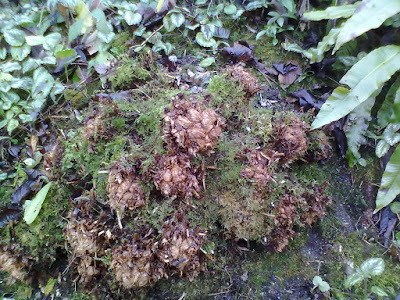It is very much the same problem and the same principle as for the Hellebores: the old leaves reach a point where they are getting tatty, and they do obstruct the new fronds - but on the other hand, people say "Oh, but you should leave the old fronds there for frost protection".
It really isn't necessary, ferns are as tough as old boots, unless you live in an area with really hard winters. In this particular garden, the whole of this area is a massive frost pocket, as it is set within a deep valley, so the frost just sits there. And yet the ferns survive..
Here is the problem - the fern fronds have lost their fresh greenness and are getting quite brown and tatty, worsened in this case by having the brambles hauled down from above, when we cleared the upper bank of the worst of the top-growth (more of that another time).
A fern in this condition is no use to man or beast, and it is time to clear it away.
Looked at more closely, you can see that each frond has its own brown stalk, and they emerge from a knobbly brown base.
As the plant ages, these knobbles become huge, several inches across, and you often find knobbles growing out of other knobbles.
All you have to do is take your secateurs, and carefully snip off each brown stem, as close to the knobble as you can reach.
Here we are, halfway through the job.
You can see that this fern is actually a collection of smaller knobbles, where it has expanded over the years.
If I wanted to increase the fern bed, I would use a spade to chop off some of the outlying knobbles, getting a good chunk of root with each one. These would then be planted out, and the original plant would quickly fill in the gaps, so by next summer you would not notice that it had been split up.
Here is the whole thing, all fronds cut, and you can see that I have taken the opportunity to remove as much of the encroaching Lamium as I could.
I did also try to get off as much moss as possible, but it was firmly attached and I didn't want to risk damaging the new fronds.
This is an excellent time of year to do this job, as the new fronds are still tightly packed - can you see those smooth, lighter brown mini-kobbles? Each of those is a new frond, just waiting for spring. And when they are still tightly-packed like this, there is no chance of damaging them.
Here is the same clump, fully cleaned up and ready for spring.
You can see that I am trying to keep the Lamium to the area above the fern layer: this is to keep the Hellebore area free, not just for the convenience of the Hellebores, but because I am gradually filling up the lowest area with Common Spotted Orchids, and I don't want them to be swamped by the over-vigorous Lamium. It means that the Hellebore area is comparatively bare and uninteresting at this time of year, but only for a couple of weeks until the Hellebores start flowering, and I think it is well worth it, to preserve and encourage the tiny Orchids.
Luckily for me, the Client agrees!
And what of the cut-off fronds? Compost, or not compost? I still don't have a definitive answer on this one. Personally I don't compost them, partly due to the millions of spores on them - I don't want to spend my life weeding out baby ferns - and mostly because I think they are too "tough" for composting, and that the mid-ribs would be persistent in the compost for too long.
The internet is no help at all here: some people say yes, some say no: there is a huge confusion about what is a fern, and what is bracken (they are different) and what difference it will make to the ph of the soil, and so on. So I will stick to my own principles for now, and as my composting is all done in "normal" gardens, not on a commercial scale, I will continue to put fern fronds on the bonfire heap, using the ash later on for other purposes.
If you have any thoughts or comments on the matter of composting ferns, I would be delighted to hear from you!
Did you enjoy this article? Did you find it useful? Would you like me to answer your own, personal, gardening question? Become a Patron - just click here - and support me! Or use the Donate button for a one-off donation. If just 10% of my visitors gave me a pound a month, I'd be able to spend a lot more time answering all the questions!!





No comments:
Post a Comment
Comments take around 2 days to appear: please be patient. Excessive SPAM has forced me to restrict comments to just Members: if you have a question, you can become a Member: or you can hop over to Patreon and join me there: or you can email me direct - my email address is in the right-hand pane. Sorry about this, but honestly, the spam! I'm drowning in it!!
Note: only a member of this blog may post a comment.